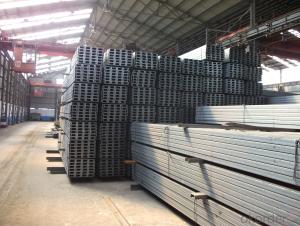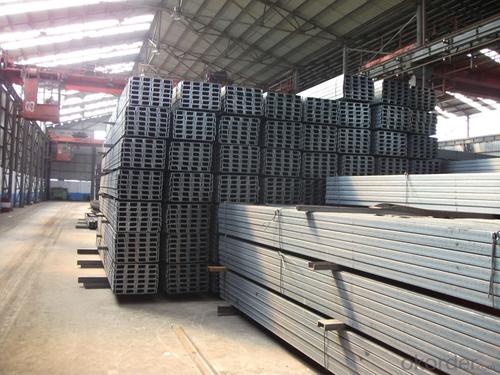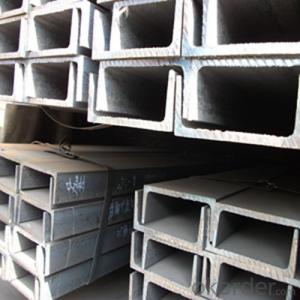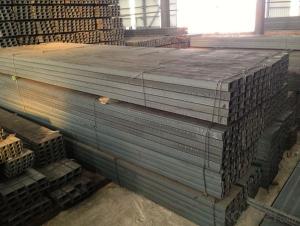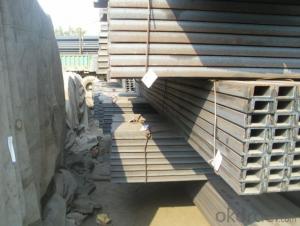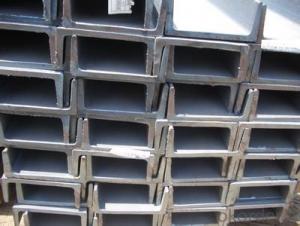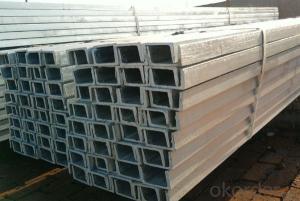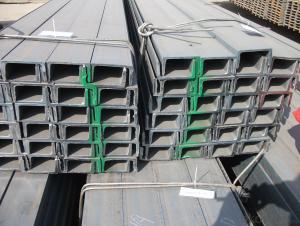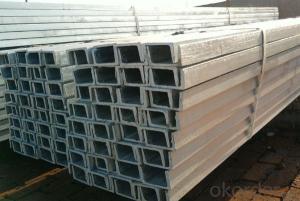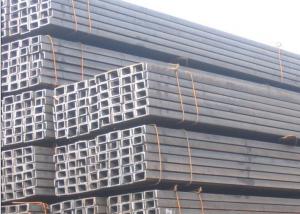HOT ROLLED U CHANNEL 75*40 6M JIS STANDER
- Loading Port:
- Qingdao
- Payment Terms:
- TT OR LC
- Min Order Qty:
- 50 m.t.
- Supply Capability:
- 10000 m.t./month
OKorder Service Pledge
OKorder Financial Service
You Might Also Like
Product Description:
Specifications of MS Channel:
1.We supply high quality MS Channel at reasonable price, including Chinese standard, Japanese standard and so on.
Standard | GB/JIS |
Material Grade | Q235,SS400 |
Technique: | Hot Rolled |
Sizes as per chinese standard: | 50*37*4.5mm - 300*89*11.5mm |
Sizes as per japanese standard: | 50*25*3mm – 200*80*7.5mm |
Length: | 6meter, 9meter, 12meter |
Note: 1.we are also competent to provide our customers other MS Channel based on other sizes according to customer’s requirements.
2. The length of our ms channel could be cut into other meters as per customer’s requirements. For example, the channel in 6meters could be cut into 5.8meters in order to be fit in the 20ft container.
2. The detailed sections of MS Channel as per GB standard.are shown in the table-1:
GB U CHANNEL | Standard | Sectional | Dimension |
| Mass: |
| (mm) | (mm) | (mm) | (mm) |
|
50X37 | 50 | 37 | 4.50 | 7.0 | 5.438 |
63X40 | 63 | 40 | 4.80 | 7.5 | 6.634 |
80x43 | 80 | 43 | 5.00 | 8.0 | 8.045 |
|
|
|
|
|
|
100x48 | 100 | 48 | 5.30 | 8.5 | 10.007 |
120x53 | 120 | 53 | 5.50 | 9.0 | 12.059 |
140x58 | 140 | 58 | 6.00 | 9.5 | 14.535 |
140x60 | 140 | 60 | 8.00 | 9.5 | 16.733 |
|
|
|
|
|
|
160x63 | 160 | 63 | 6.50 | 10.0 | 17.240 |
160x65 | 160 | 65 | 8.50 | 10.0 | 19.752 |
|
|
|
|
|
|
180x68 | 180 | 68 | 7.00 | 10.5 | 20.174 |
180x70 | 180 | 70 | 9.00 | 10.5 | 23.000 |
|
|
|
|
|
|
200x73 | 200 | 73 | 7.00 | 11.0 | 22.637 |
200x75 | 200 | 75 | 9.00 | 11.0 | 25.777 |
|
|
|
|
|
|
220x77 | 220 | 77 | 7.00 | 11.5 | 24.999 |
220x79 | 220 | 79 | 9.00 | 11.5 | 28.453 |
|
|
|
|
|
|
250x78 | 250 | 78 | 7.00 | 12.0 | 27.410 |
250x80 | 250 | 80 | 9.00 | 12.0 | 31.335 |
250x82 | 250 | 82 | 11.00 | 12.0 | 35.260 |
|
|
|
|
| |
280x82 | 280 | 82 | 7.50 | 12.5 | 31.427 |
280x84 | 280 | 84 | 9.50 | 12.5 | 35.823 |
280x86 | 280 | 86 | 11.50 | 12.5 | 40.219 |
|
|
|
|
|
|
300x85 | 300 | 85 | 7.50 | 13.5 | 34.463 |
300x87 | 300 | 87 | 9.50 | 13.5 | 39.173 |
300x89 | 300 | 89 | 11.50 | 13.5 | 43.883 |
Table-1
3. The chemical composition of HR Channel Steel according to Q235B is shown in Table-2.
Alloy No | Grade | Element(%) | ||||
C | Mn | S | P | Si | ||
Q235 | B | 0.12-0.20 | 0.3-0.7 | ≦0.045 | ≦0.045 | ≦0.3 |
Table-2
Note: we are able to present our customers relevant SGS test report for chemical composition of HR Channel Steel.
4. The mechanical property of HR Channel Steel according to Q235B is shown in Table-3-1 and Table-3-2
Alloy No | Grade | Yielding Strength Point(Mpa) | |||
Thickness(mm) | |||||
≦16 | >16-40 | >40-60 | >60-100 | ||
≧ | |||||
Q235 | B | 235 | 225 | 215 | 205 |
Table-3-1
Alloy No | Grade | Tensile Strength(Mpa) | Elongation After Fracture(%) | |||
Thickness(mm) | ||||||
≦16 | >16-40 | >40-60 | >60-100 | |||
≧ | ||||||
G235 | B | 375-500 | 26 | 25 | 24 | 23 |
Table-3-2
Note: we are able to present our customers relevant SGS test report for mechanical property of MS Channel as customer’s request.
Applications of MS Channel:
The MS Channel can be applied to construction of warehouses, workshops, sport stadiums and car parks etc.The hot rolled channel steel belongs to carbon structural steel which is applied to in the field of construction and machinery.In details, the hot rolled channel steel is usually used for arch-itechtural structure, and they could be welded in order to support or hang a vari-ety of facilities. They are also usually used in combination with I beam. Generally,the hot rolled channel steel we supply must possess perfect welding property, riveting property and mechanical property and so on.
Package & Delivery of MS Channel:
1.The hot rolled channel steel will be packed in bundle with steel wire at each end of every bundle and color marking in order to help the customer to recognize his goods more easily at sight.
2. And the hot rolled channel steel could be loaded into 20ft or 40ft container, or by bulk cargo.If the weight of each bundle reaches more than 3.5 mt, the loading by break bulk cargo should be choosed.When the weight of each bundle reaches less than 3mt, the loading by container should be choosed.
3.As for the transportaion from mill to loading port, the truck will be usually used. And the maximum quantity for each truck is 40mt.
4.All in all, we could do in accordance with customer's request.
- Q: In the steel structure of steel purlin 160*60*20*2.5 is what mean
- Steel structure is mainly made of steel material, and it is one of the main types of building structure. The structure is mainly composed of steel beams and steel plates, such as steel beams, steel columns, steel trusses and so on. Each component or component is usually connected with welds, bolts or rivets. Because of its light weight and simple construction, it is widely used in large factories, stadiums, super high-rise and other fields.
- Q: 10# how much is it per kilogram of channel steel?
- National standard:Hot rolled plain channel [(GB) 707-65] (unit mm)Height =100, leg width =48, waist thickness =5.3, average leg thickness =8.5, inner arc radius =8.5, leg end arc radius =4.25, sectional area (cm2) =12.74, theoretical weight (kg/m) =10.00
- Q: Can steel channels be used in water treatment plants?
- Yes, steel channels can be used in water treatment plants. Steel is commonly used in water treatment plants due to its durability, strength, and resistance to corrosion. Steel channels can be utilized for various purposes such as supporting equipment, creating walkways, or providing structural support for pipelines and conduits. However, it is important to consider the specific requirements and conditions of the water treatment plant, such as the type of water being treated and any potential chemical or environmental factors that may affect the steel channels. Proper coating or protection may be necessary to prevent corrosion and ensure the longevity of the steel channels in a water treatment plant environment.
- Q: What are the factors to consider when determining the appropriate height of a steel channel?
- When determining the appropriate height of a steel channel, several factors need to be considered. These factors include the load-bearing capacity required, the span or distance between supports, the type and weight of the load being supported, the material properties of the steel channel, and the desired deflection or bending of the channel under load. Firstly, it is crucial to assess the load-bearing capacity required for the steel channel. This involves considering the maximum weight the channel needs to support without buckling or failing. The load-bearing capacity depends on the application and the anticipated loads that will be applied to the channel. The span or distance between supports is another critical factor. Longer spans generally require taller steel channels to provide adequate support and minimize deflection. Shorter spans, on the other hand, may allow for smaller and less rigid channels. The type and weight of the load being supported are also important considerations. Different loads exert different forces on the channel, such as point loads or uniformly distributed loads. Heavier loads will require taller and stronger steel channels to ensure structural integrity. The material properties of the steel channel play a role in determining the appropriate height. Different steel alloys have different strength and stiffness properties. The choice of alloy will depend on the load requirements and the structural design. Lastly, the desired deflection or bending of the channel under load needs to be considered. Deflection refers to the amount of flex or bending that the channel experiences when loaded. In some applications, minimal deflection is desired, while in others, some deflection may be acceptable. In conclusion, when determining the appropriate height of a steel channel, it is vital to consider factors such as load-bearing capacity, span, type and weight of the load, material properties, and desired deflection. A thorough analysis of these factors will help ensure the steel channel is appropriately sized and capable of meeting the intended structural requirements.
- Q: Are steel channels suitable for earthquake-prone regions?
- Steel channels are indeed suitable for earthquake-prone regions. Steel is known for its high strength and ductility, making it a popular choice for earthquake-resistant construction. Steel channels, in particular, offer several advantages in seismic regions. Firstly, steel channels possess excellent load-bearing capabilities, allowing them to withstand the forces generated during an earthquake. Their shape provides structural rigidity and stability, minimizing the risk of collapse or damage. Steel's inherent flexibility also enables it to absorb and dissipate seismic energy, reducing the impact on the overall structure. Additionally, steel channels can be easily customized and fabricated to meet specific building requirements. This adaptability allows engineers to design structures with appropriate seismic resistance, ensuring that they can withstand the expected ground motion. Steel channels' dimensional accuracy and uniformity also contribute to better construction quality and performance during earthquakes. Another advantage of steel channels is their fire resistance. Unlike other building materials, such as wood or concrete, steel does not burn or contribute to the spread of fire. This characteristic makes steel channels a safer choice for earthquake-prone regions, where fires can often occur due to ruptured gas lines or electrical failures during seismic events. Moreover, steel's durability and resistance to corrosion make it ideal for long-term use in earthquake-prone areas. Steel channels require minimal maintenance and have a longer lifespan compared to other materials, ensuring the continued safety and stability of structures over time. In conclusion, steel channels are highly suitable for earthquake-prone regions due to their strength, ductility, load-bearing capabilities, adaptability, fire resistance, and durability. These qualities make steel channels a reliable choice for constructing earthquake-resistant buildings that can withstand the forces generated by seismic events.
- Q: Standard for channel 20
- According to the GB / T 707 - 1998 hot-rolled steel GB, No. 20 channel is divided into: 20A; 20b two.20A: height: 200 mm width: 73 mm thickness: 7 mm weight: 22.637 kg / m theory.20b: height: 200 mm width: 75 mm thickness: 9 mm weight: 25.777 kg / m theory.(Note: the theoretical weight calculation of steel hot-rolled steel according to the density of 7.85 g / cm3)
- Q: Are steel channels suitable for residential construction?
- Residential construction can indeed benefit from the use of steel channels. Known as C-channels or U-channels, steel channels are frequently employed in construction due to their strength and durability. They commonly serve as structural elements in framing systems, delivering support and stability to buildings. Steel channels possess numerous advantages that render them suitable for residential construction. Firstly, their high strength-to-weight ratio allows them to bear heavy loads while remaining relatively lightweight. This makes them ideal for constructing floors, walls, and roofs within residential structures. Additionally, steel channels exhibit exceptional resistance to fire, termites, and other pests, which are concerns in residential areas. Unlike materials like wood, they do not warp, rot, or decay, ensuring a longer lifespan for the building. Moreover, steel channels are easily fabricated and installed, streamlining the construction process. They can be cut and shaped to the desired dimensions, allowing for design flexibility. Furthermore, they can be effortlessly connected and welded, guaranteeing strong connections and minimizing the risk of structural failures. Finally, steel channels prove to be cost-effective in the long run. Although they may have a higher initial cost compared to certain materials, their durability and low maintenance requirements result in reduced repair and replacement expenses over time. Nevertheless, it is crucial to consider the specific requirements and regulations of the residential construction project. Consulting professionals, such as architects and engineers, is imperative to ensure the suitability of steel channels for the particular application.
- Q: Can steel channels be used for solar panel installations?
- Certainly, solar panel installations can make use of steel channels. The reason steel channels are frequently employed as a mounting structure for solar panels lies in their robustness and longevity. They offer a firm framework for securely fastening the panels, guaranteeing their ability to endure diverse weather conditions and maintain their position for an extended duration. Moreover, steel channels can be effortlessly tailored and welded to cater to the unique needs of the solar panel installation, rendering them a versatile selection for this purpose. In conclusion, steel channels are a dependable and widely favored choice for securely and effectively mounting solar panels.
- Q: How do steel channels contribute to the stability of a structure during tornadoes?
- Steel channels contribute to the stability of a structure during tornadoes by providing structural support and reinforcement. They are typically used as beams or columns to distribute loads and resist the strong wind forces generated by tornadoes. The high strength and rigidity of steel channels enable them to withstand the intense pressures and vibrations caused by tornadoes, helping to prevent structural failure and collapse.
- Q: How big is the channel used for the 4 metre span?
- The same height of the I-beam, if there are several different leg width and waist thickness, should be added on the right side of the model a, B, C to distinguish, such as 32a#, 32b#, 32c# and so on. The I-beam is made of ordinary I-beam and light I-beam, and the specification for hot-rolled ordinary I-beam is 10-63#. Standard Specification for hot-rolled ordinary I-beam supplied by supply and demand agreement is 12-55#. I-beam is widely used in various building structures, bridges, vehicles, supports, machinery and so on.
Send your message to us
HOT ROLLED U CHANNEL 75*40 6M JIS STANDER
- Loading Port:
- Qingdao
- Payment Terms:
- TT OR LC
- Min Order Qty:
- 50 m.t.
- Supply Capability:
- 10000 m.t./month
OKorder Service Pledge
OKorder Financial Service
Similar products
Hot products
Hot Searches
Related keywords
